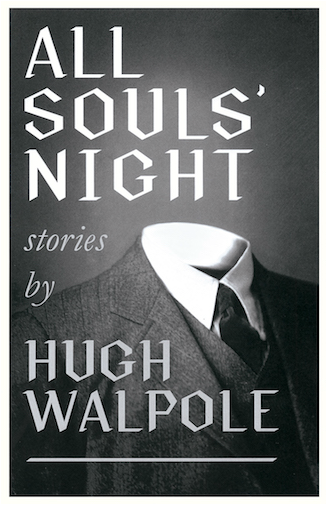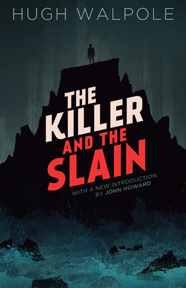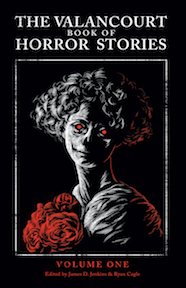|
BOOK DETAILS
Trade paper ISBN-13: 978-1943910359 List Price: $17.99 U.S. Pages: 238 Published: 2016 |
All Souls’ Night (1933)
Hugh Walpole With a new introduction by John Howard “All these [tales] are excellent and ‘The Silver Mask’ an absolute masterpiece, so eerily inexorable in its development that it should be as famous as Shirley Jackson’s ‘The Lottery’ or Charlotte Perkins Gilman’s ‘The Yellow Wallpaper.’ ” - Michael Dirda, Washington Post Book Description
Hugh Walpole (1884-1941) was one of the most popular and prolific English authors of his time, best known for his historical fiction and novels for boys. But it was in the field of the macabre and supernatural that Walpole was at his best, and this collection of sixteen tales contains many of his finest, including the classic werewolf story ‘Tarnhelm’; the oft-anthologized ‘The Little Ghost’; ‘The Snow’, a chilling story of vengeance from beyond the grave; and perhaps the highlight of the collection, ‘The Silver Mask’, which one critic has called ‘a masterpiece, a classic example of how a tale can be truly terrible and ghostly with no ghost and only the wispiest hint of the supernatural.’ This new edition, which reprints the unabridged text of the 1933 first edition and includes a new introduction by John Howard, will allow a new generation of readers to discover an unjustly forgotten master of the eerie and macabre. |
reviews
‘Excellently written and displaying a wide range of interests . . . Mr. Walpole knows well how to make the flesh creep.’ - Sydney Morning Herald
‘There are sixteen stories in Walpole’s collection, and they all reach a high degree of merit; all are marked by the distinguished literary quality one is sure to find in his work.’ - New York Times
‘A macabre master whose understanding of the night side of human experience makes him indispensable fire-side reading.’ - Flesh and Blood Magazine
‘There are sixteen stories in Walpole’s collection, and they all reach a high degree of merit; all are marked by the distinguished literary quality one is sure to find in his work.’ - New York Times
‘A macabre master whose understanding of the night side of human experience makes him indispensable fire-side reading.’ - Flesh and Blood Magazine
ALSO AVAILABLE THROUGH ONLINE RETAILERS
MORE TITLES BY THIS AUTHOR
AUTHOR BIOGRAPHY

Hugh Walpole was born in Auckland, New Zealand in 1884 and as a boy was sent to England to be educated. Bullied and miserable at school, young Walpole took refuge in the library, where he devoured the novels of Austen, Scott, Trollope and others, and he knew from an early age that he wanted to become a novelist. From 1903 to 1906, Walpole studied at Emmanuel College, Cambridge, and it was during this time that he first began to acknowledge his homosexuality. His attention was fixated for a time on A. C. Benson, whom he met as an undergraduate and who helped Walpole enter into a correspondence with Henry James, whom Walpole greatly admired and whose works would influence Walpole’s own.
Walpole’s first novel was The Wooden Horse (1909), but his first success was Mr. Perrin and Mr. Traill (1911), which received good reviews and sold well; it also earned the admiration of Arnold Bennett, who would go on to be a good friend. Walpole’s career was further aided by a 1914 article by James in the Times Literary Supplement, in which he ranked Walpole with D. H. Lawrence and Compton Mackenzie as one of the important young English writers of his generation.
During the First World War, Walpole was rejected for service because of poor eyesight, so he went to Russia and assisted at hospitals, on one occasion single-handedly saving a Russian officer and earning the Cross of St. George. His experiences in Russia helped form the basis for his successful novels The Dark Forest (1916) and The Secret City (1919) and also earned him a CBE in 1918.
After the war, Walpole continued to write prolifically, usually publishing at least one very long novel each year. His output was diverse and included the popular “Herries” cycle of novels set in 18th-century England, as well as boys’ stories featuring the character Jeremy, and what he called his “macabre” novels, including Portrait of a Man with Red Hair (1925). In addition to his writing, Walpole toured America extensively as a public speaker, winning great popularity and earning huge sales for his books in the United States.
During the 1930s, Walpole spent time in Hollywood, writing scripts for the films David Copperfield (1935) and Little Lord Fauntleroy (1936), and in 1937 he accepted a knighthood. At the start of the Second World War, Walpole remained in London and continued to write, working on his final macabre novel, The Killer and the Slain (1942), which was published posthumously. Walpole had long suffered from diabetes and his poor health, combined with the strain of his furious writing pace, probably contributed to his early death at age 57 in 1941.
Walpole’s reputation had already begun to decline by the 1930s as he was increasingly seen as outdated by many critics, and it took a devastating hit when he was parodied in Somerset Maugham’s Cakes and Ale (1930). A Times obituary that characterized Walpole as a “workmanlike” writer, “ambitious,” and “a sentimental egotist” who “was not popular among his fellow-writers” further damaged his reputation, which is only now seeing signs of a revival with recent reprints (and a stage adaptation) of the Herries novels in the UK and a new Valancourt edition of The Killer and the Slain.
Walpole’s first novel was The Wooden Horse (1909), but his first success was Mr. Perrin and Mr. Traill (1911), which received good reviews and sold well; it also earned the admiration of Arnold Bennett, who would go on to be a good friend. Walpole’s career was further aided by a 1914 article by James in the Times Literary Supplement, in which he ranked Walpole with D. H. Lawrence and Compton Mackenzie as one of the important young English writers of his generation.
During the First World War, Walpole was rejected for service because of poor eyesight, so he went to Russia and assisted at hospitals, on one occasion single-handedly saving a Russian officer and earning the Cross of St. George. His experiences in Russia helped form the basis for his successful novels The Dark Forest (1916) and The Secret City (1919) and also earned him a CBE in 1918.
After the war, Walpole continued to write prolifically, usually publishing at least one very long novel each year. His output was diverse and included the popular “Herries” cycle of novels set in 18th-century England, as well as boys’ stories featuring the character Jeremy, and what he called his “macabre” novels, including Portrait of a Man with Red Hair (1925). In addition to his writing, Walpole toured America extensively as a public speaker, winning great popularity and earning huge sales for his books in the United States.
During the 1930s, Walpole spent time in Hollywood, writing scripts for the films David Copperfield (1935) and Little Lord Fauntleroy (1936), and in 1937 he accepted a knighthood. At the start of the Second World War, Walpole remained in London and continued to write, working on his final macabre novel, The Killer and the Slain (1942), which was published posthumously. Walpole had long suffered from diabetes and his poor health, combined with the strain of his furious writing pace, probably contributed to his early death at age 57 in 1941.
Walpole’s reputation had already begun to decline by the 1930s as he was increasingly seen as outdated by many critics, and it took a devastating hit when he was parodied in Somerset Maugham’s Cakes and Ale (1930). A Times obituary that characterized Walpole as a “workmanlike” writer, “ambitious,” and “a sentimental egotist” who “was not popular among his fellow-writers” further damaged his reputation, which is only now seeing signs of a revival with recent reprints (and a stage adaptation) of the Herries novels in the UK and a new Valancourt edition of The Killer and the Slain.




